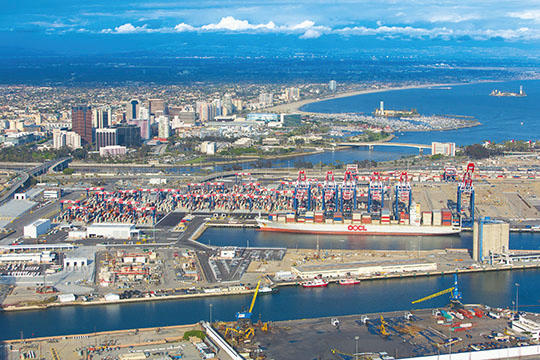The Port of Long Beach’s newly upgraded Middle Harbor terminal, considered by port and industry officials the most environmentally friendly and technologically advanced marine terminal in the world, was brought online this month with its first vessel call.
The facility’s opening comes after the first phase of the Middle Harbor Redevelopment Project, in which two aging terminals are being combined into one large modernized terminal facility for Orient Overseas Container Line (OOCL) and its subsidiary Long Beach Container Terminal, Inc. (LBCT), was completed last year.
The terminal, located on piers D, E and F, utilizes zero-emission automated guided vehicles (AGVs) and is equipped with environmentally-friendly capabilities, including shoreside electrical power for ships, expanded on-dock rail for moving more cargo by trains rather than trucks, cleaner yard equipment, electrical stacking cranes and solar panels.

The first phase of the Middle Harbor terminal (center) at the Port of Long Beach was completed last year with the latest technologically advanced cargo handling equipment, including the all-electric stacking cranes, automated guided vehicles (AGVs) and solar panels. The terminal operated by Orient Overseas Container Line’s (OOCL) subsidiary Long Beach Container Terminal, Inc. (LBCT) went live this month. The next phase is to be completed in 2019. Pictured in the foreground is a cement terminal. (Port of Long Beach photograph)
In addition, the terminal ensures the use of low-sulfur fuels for main and auxiliary engines on ships, and applies the port’s Green Flag Vessel Speed Reduction program requirements. Also, the terminal was built using Leadership in Energy and Environmental Design (LEED) building standards, and the design took into account storm water pollution prevention measures. The project reuses and recycles waste materials, such as concrete, steel, copper and other construction materials.
The $1.3 billion project, which launched in 2011, has always been a joint effort between OOCL, LBCT, the Port of Long Beach and the International Longshore and Warehouse Union (ILWU), Anthony Otto, president of LBCT, wrote in an e-mail to the Business Journal. As a result of that partnership, the “go live” date for the terminal was on schedule and “an operational success,” he said.
“OOCL and LBCT have invested significantly to create the world’s first zero-emission terminal facility and we hope this investment inspires others to do the same,” Otto said. “As a terminal operator, we see no better way to meet the demands of both our customers and the community in which we operate.”
The redevelopment project, which is expected to support 14,000 new jobs in Southern California from the additional cargo, will “re-set the industry standard on efficiency, environmental stewardship and operational excellence,” he said.
“We are proud to take ownership of the most technologically advanced terminal in the world,” Otto added.
Glenn Farren, director of tenant services and operations at the Port of Long Beach, said the Middle Harbor terminal, when fully completed in 2019, will increase the amount of cargo the port can handle by 20 percent.
Additionally, the new terminal will improve the port’s cargo velocity, reduce truck waiting times and improve service reliability while providing a model as the “world’s greenest terminal,” Farren said.
Rick Cameron, the port’s managing director of planning and environmental affairs, added that, while Middle Harbor is considered the port’s “signature project” in terms of upgrading infrastructure to be more environmentally friendly and utilizing zero-emission equipment, not every terminal is ready for such a change.
“It’s going to take time and not everybody probably wants to be just like Middle Harbor,” Cameron said. “But we want to make sure that we’ve got the technologies and the ability to have flexibility for those terminals to move into zero emission equipment.”
